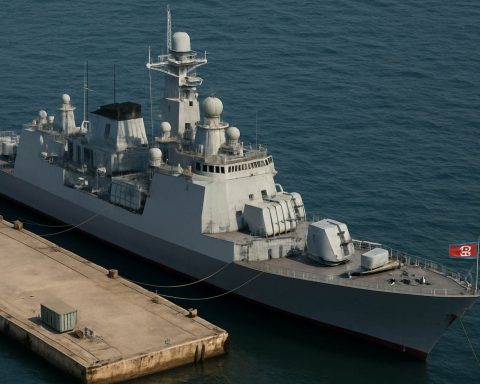F-22 Raptor: The Pinnacle of American Stealth and Air Superiority Capabilities
- Market Overview
- Emerging Technology Trends
- Competitive Landscape Analysis
- Growth Forecasts and Projections
- Regional Market Analysis
- Future Outlook and Strategic Directions
- Key Challenges and Emerging Opportunities
- Sources & References
“The Lockheed Martin F-22 Raptor is a fifth-generation stealth fighter jet renowned as one of the most formidable air superiority fighters ever built.” (source)
Market Overview
The F-22 Raptor, developed by Lockheed Martin for the United States Air Force, remains the world’s premier air superiority fighter, renowned for its unmatched stealth, agility, and advanced avionics. Since its introduction in 2005, the F-22 has set the standard for fifth-generation fighter aircraft, combining low observability with supercruise capability and integrated sensor fusion. As of 2024, the U.S. Air Force operates approximately 183 F-22s, with no new production planned due to high costs and shifting defense priorities (Lockheed Martin).
The global fighter aircraft market is projected to reach $131.5 billion by 2030, growing at a CAGR of 4.2% from 2023, driven by increasing defense budgets and the demand for next-generation air dominance platforms (Fortune Business Insights). However, the F-22 remains unique: U.S. law prohibits its export, making it an exclusive asset of the U.S. military and a key component of America’s air superiority strategy.
- Stealth and Survivability: The F-22’s radar cross-section is among the lowest of any operational fighter, allowing it to penetrate contested airspace with minimal detection (U.S. Air Force).
- Performance: Capable of supercruise at Mach 1.8 without afterburners and equipped with thrust-vectoring engines, the F-22 outmaneuvers all current adversaries.
- Avionics: Advanced sensor fusion and electronic warfare systems provide pilots with superior situational awareness and targeting capabilities.
Despite its technological edge, the F-22 faces challenges. The high operational cost—estimated at $85,325 per flight hour—and limited fleet size have prompted the Air Force to prioritize the development of the Next Generation Air Dominance (NGAD) program, which aims to field a sixth-generation fighter by the 2030s (Defense News).
In summary, the F-22 Raptor remains a symbol of American air power, unmatched in its role but facing an evolving market landscape as new technologies and strategic priorities emerge.
Emerging Technology Trends
The F-22 Raptor remains at the forefront of emerging technology trends in military aviation, representing the pinnacle of American air superiority. Developed by Lockheed Martin and introduced into service in 2005, the F-22 combines stealth, supercruise, advanced avionics, and unmatched maneuverability, making it a formidable force in modern aerial combat.
One of the F-22’s most significant technological advantages is its stealth capability. The aircraft’s shape, coating, and internal weapons bays minimize radar cross-section, allowing it to evade detection by enemy radar systems. This stealth technology is continually updated, ensuring the F-22 remains ahead of evolving air defense threats (Lockheed Martin).
The F-22 is powered by two Pratt & Whitney F119-PW-100 turbofan engines, enabling it to supercruise—sustain supersonic flight without afterburners—at speeds above Mach 1.5. This capability allows the Raptor to intercept and engage threats rapidly, outpacing most adversaries (U.S. Air Force).
Advanced avionics and sensor fusion are central to the F-22’s dominance. Its AN/APG-77 radar provides long-range detection and tracking, while integrated electronic warfare systems enhance survivability and lethality. The cockpit features a glass display and voice command capabilities, streamlining pilot workload and situational awareness (National Defense Magazine).
Despite its technological edge, the F-22 program was capped at 187 operational aircraft due to high costs and shifting defense priorities. However, the U.S. Air Force continues to invest in upgrades, including new sensors, improved data links, and enhanced weapons integration, to ensure the Raptor’s relevance against near-peer adversaries like China and Russia (Defense News).
- Stealth: Advanced radar-evading design and materials
- Supercruise: Sustained supersonic flight without afterburners
- Avionics: Sensor fusion and electronic warfare capabilities
- Upgrades: Ongoing modernization to counter emerging threats
As global air combat technology evolves, the F-22 Raptor stands as a testament to American innovation, maintaining its status as the world’s premier stealth air superiority fighter.
Competitive Landscape Analysis
The F-22 Raptor, developed by Lockheed Martin, remains the cornerstone of U.S. air dominance, widely regarded as the world’s premier air superiority fighter. Since its introduction in 2005, the F-22 has set the benchmark for stealth, agility, and integrated avionics, making it a formidable competitor in the global fighter aircraft market. Despite the cessation of its production in 2012, the F-22’s technological edge continues to shape the competitive landscape of fifth-generation fighters.
- Stealth and Performance: The F-22’s radar cross-section is significantly lower than that of its peers, thanks to advanced shaping and radar-absorbent materials. Its supercruise capability—sustained supersonic flight without afterburners—remains unmatched, allowing it to engage and disengage at will (Lockheed Martin).
- Avionics and Sensor Fusion: The Raptor’s sensor suite, including the AN/APG-77 AESA radar, provides pilots with unparalleled situational awareness. Its ability to fuse data from multiple sources gives it a decisive edge in both air-to-air and air-to-ground missions (U.S. Air Force).
- Global Competitors: The F-22’s closest rivals are the Russian Su-57 Felon and the Chinese J-20 Mighty Dragon. While both aircraft boast stealth features and advanced avionics, analysts note that neither matches the F-22’s combination of stealth, speed, and agility (RAND Corporation). The U.S. decision to prohibit F-22 exports has prevented direct competition in the international market, but it has also spurred rivals to accelerate their own fifth-generation programs.
- Fleet Size and Modernization: As of 2024, the U.S. Air Force operates approximately 183 F-22s, with ongoing upgrades to avionics, weapons, and electronic warfare systems to maintain superiority (Defense News). The F-35 Lightning II, also from Lockheed Martin, is being produced in greater numbers and exported widely, but it is designed as a multirole fighter rather than a pure air superiority platform.
In summary, the F-22 Raptor’s unmatched capabilities ensure its continued dominance in the air superiority role, even as global competitors strive to close the gap. Its influence is evident in the design priorities of emerging fifth-generation fighters worldwide.
Growth Forecasts and Projections
The F-22 Raptor, developed by Lockheed Martin, remains the cornerstone of America’s air superiority strategy, renowned for its unmatched stealth, agility, and advanced avionics. As of 2024, the U.S. Air Force operates approximately 183 F-22s, with no new production planned due to the program’s closure in 2012 (Air & Space Forces Magazine). Despite the halt in manufacturing, the F-22’s operational relevance and projected upgrades ensure its continued dominance in the near term.
Growth forecasts for the F-22 Raptor focus on modernization rather than fleet expansion. The U.S. Air Force has committed to significant investments in avionics, sensor fusion, and electronic warfare upgrades through the Advanced Raptor Enhancement and Sustainment (ARES) program, with funding exceeding $12 billion through 2030 (Defense News). These enhancements are designed to maintain the F-22’s edge against emerging threats, particularly from near-peer adversaries such as China and Russia.
Projections indicate that the F-22 will remain a critical component of the U.S. fighter fleet until at least the mid-2030s, when the Next Generation Air Dominance (NGAD) platform is expected to begin replacing it (Air & Space Forces Magazine). The Air Force’s 2024 budget proposal includes plans to retire older F-22s used primarily for training, while retaining and upgrading the most combat-capable jets (Defense News).
- Operational Longevity: The F-22 is expected to serve in front-line roles for at least another decade, with incremental upgrades ensuring its viability.
- Modernization Focus: Investments in stealth coatings, radar, and electronic warfare systems will keep the F-22 relevant against evolving threats.
- Transition to NGAD: The F-22’s eventual replacement will be gradual, with overlapping service as NGAD platforms are fielded in the 2030s.
In summary, while the F-22 Raptor’s production line remains closed, its future is defined by robust modernization efforts and a strategic role in U.S. air dominance until next-generation systems are fully operational.
Regional Market Analysis
The F-22 Raptor, developed by Lockheed Martin, remains the cornerstone of the United States’ air superiority strategy. As the world’s first fifth-generation stealth fighter, the F-22 is exclusively operated by the U.S. Air Force, with no export variants due to congressional restrictions. This exclusivity has significant implications for regional air power balances, particularly in North America, Europe, and the Asia-Pacific.
North America
- The U.S. Air Force maintains a fleet of approximately 183 F-22 Raptors, stationed primarily at bases such as Joint Base Elmendorf-Richardson (Alaska), Langley Air Force Base (Virginia), and Nellis Air Force Base (Nevada) (U.S. Air Force).
- This concentration ensures rapid response capabilities across the continent and provides a technological edge over potential adversaries in the Western Hemisphere.
Europe
- While the F-22 is not based in Europe, the U.S. regularly deploys Raptors to NATO allies for joint exercises and deterrence missions, particularly in response to increased Russian military activity (Defense News).
- These deployments reinforce NATO’s air defense posture and demonstrate the U.S. commitment to regional security, especially in Eastern Europe and the Baltics.
Asia-Pacific
- The strategic positioning of F-22s at bases like Kadena Air Base (Japan) and rotational deployments to Guam underscore the U.S. focus on countering China’s growing air power and regional assertiveness (Reuters).
- These forward deployments enhance deterrence and reassure allies such as Japan and South Korea, who face advanced threats from both China and North Korea.
Global Impact
- The F-22’s unmatched stealth, supercruise, and sensor fusion capabilities set a high bar for rival air forces. Russia’s Su-57 and China’s J-20, while advanced, have yet to match the operational maturity and combat readiness of the Raptor (RAND Corporation).
- The Raptor’s presence in key regions acts as a force multiplier, shaping adversary planning and underpinning U.S. and allied air dominance.
Future Outlook and Strategic Directions
The future outlook for the F-22 Raptor, America’s premier stealth air superiority fighter, is shaped by evolving global threats, technological advancements, and shifting defense priorities. Despite its unmatched capabilities in stealth, agility, and situational awareness, the F-22 faces both opportunities and challenges as the U.S. Air Force charts its strategic direction for air dominance.
Currently, the U.S. Air Force operates approximately 183 F-22 Raptors, with no new production planned since the line was closed in 2012 (Air & Space Forces Magazine). The aircraft remains a critical component of America’s air superiority strategy, leveraging its advanced avionics, supercruise capability, and low observability to maintain a decisive edge over potential adversaries. However, the average age of the fleet is increasing, and maintenance costs are rising, prompting discussions about the platform’s long-term viability.
Looking ahead, the U.S. Air Force is investing in modernization programs to extend the F-22’s operational relevance. Upgrades include improved sensors, enhanced electronic warfare systems, and integration with next-generation weapons (Defense News). These enhancements aim to ensure the Raptor can counter emerging threats, such as advanced surface-to-air missile systems and fifth-generation fighters fielded by near-peer competitors like China and Russia.
Strategically, the F-22 is expected to play a bridging role until the introduction of the Next Generation Air Dominance (NGAD) platform, projected for the 2030s (U.S. Air Force). The NGAD program will incorporate lessons learned from the F-22 and F-35, focusing on greater connectivity, autonomy, and survivability. In the interim, the F-22 will continue to serve as the tip of the spear for U.S. air superiority missions, particularly in contested environments where its stealth and performance are indispensable.
- Continued Upgrades: Ongoing investments in avionics, weapons, and survivability systems.
- Operational Integration: Closer integration with F-35s and future NGAD assets for multi-domain operations.
- Strategic Deterrence: Maintaining a credible deterrent against peer adversaries through persistent air dominance.
In summary, while the F-22 Raptor’s production has ended, its future remains vital to U.S. airpower. Through targeted upgrades and strategic integration, the Raptor will continue to underpin America’s air superiority until the next generation of fighters takes flight.
Key Challenges and Emerging Opportunities
The F-22 Raptor, developed by Lockheed Martin, remains the cornerstone of America’s air superiority strategy, renowned for its stealth, agility, and advanced avionics. However, the program faces significant challenges and evolving opportunities as global military dynamics shift and technological advancements accelerate.
-
Key Challenges
- Production Halt and Fleet Size: The F-22 production line was closed in 2012 after only 187 operational units were built, far fewer than the original plan of 750. This limited fleet size constrains deployment flexibility and increases maintenance burdens as the airframes age (Air & Space Forces Magazine).
- Maintenance and Sustainment: The F-22’s sophisticated stealth coatings and unique systems require intensive maintenance, leading to high operational costs. The Air Force has reported mission-capable rates hovering around 50-60%, below the Pentagon’s 80% target (U.S. Government Accountability Office).
- Technological Obsolescence: While still formidable, the F-22’s avionics and sensors are being outpaced by rapid advancements in electronic warfare and networked combat systems, particularly as adversaries like China and Russia field next-generation fighters (Defense News).
-
Emerging Opportunities
- Upgrades and Modernization: The U.S. Air Force is investing in incremental upgrades, including improved radar, electronic warfare capabilities, and data links to keep the F-22 relevant in contested environments (U.S. Air Force).
- Integration with Next-Generation Systems: The F-22 is being positioned as a key node in the Air Force’s Advanced Battle Management System (ABMS), enabling seamless data sharing with other platforms and unmanned systems (C4ISRNET).
- Operational Synergy: As the Next Generation Air Dominance (NGAD) program matures, the F-22 will serve as a critical bridge, providing valuable lessons and operational experience to inform future air superiority concepts (Air & Space Forces Magazine).
In summary, while the F-22 Raptor faces notable sustainment and modernization challenges, it continues to offer unique opportunities for the U.S. Air Force to maintain air dominance and shape the future of aerial warfare.
Sources & References
- F-22 Raptor: America’s Unmatched Stealth Air Superiority Fighter
- Lockheed Martin
- Fortune Business Insights
- Defense News
- National Defense Magazine
- Air & Space Forces Magazine
- Air & Space Forces Magazine
- U.S. Government Accountability Office
- C4ISRNET









